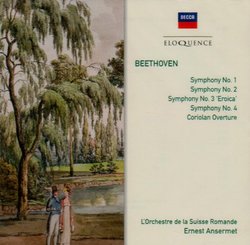I wish they'd put this all in one package
Larry VanDeSande | Mason, Michigan United States | 09/01/2009
(5 out of 5 stars)
"Ernest Ansermet (born November 11, 1883 died February 20, 1969) was one of Decca's staple of conductors in the 1950s and 1960s when he recorded this set of Beethoven symphonies with L'Orchestre de la Suisse Romande. It repesents the height of his achievement as a Beethoven interpreter. Ansermet created the Swiss orchestra after World War I and recruited its members, so it represented the sound he wanted. Like all the recordings in the Beethoven issuance, Ansermet placed the strings opposite of today -- cellos & basses left and violins right.
As a friend and peer to Toscanini, Ansermet represented many of the same traits as the Italian. Both were literalists with inherent trust in the score -- Ansermet abhorred music that was revised by a composer -- and the two had similarities in the way they performed music. Ansermet's way with Beethoven was represented by moderate speeds, extreme lucidity and clarity, and a romantic inclination. Today, he would be considered a literalit, possibly even a period performer using modern instruments, but with a romantic bent not unlike Martin Perlman.
If you've never heard Ansermet play Beethoven, this set is the best way to start. Becuase of his ear for orchestral balance and execution, he was finely attuned to the even-numbered Beethoven symphonies. I think his best performance is in Symphony No. 2 and his performance of Symphony No. 4 has been well-known for some years. I am unsure if this is the same No. 4 from his Decca Recordings set Ernest Ansermet: Decca Recordings 1953-1967 [Box Set]. In Eroica, Ansermet, like Beethoven, becomes a certified romantic with slight ritards, full-blown romantic voicing, and larger gestures than in the other symphonies. This collection also helps you decide if you want to collect them all.
My chief complaint is Australian Decca chose to divvy up "the nine" in three boxes for reasons only they know. When I last acquired this set, I had to buy the LPs then have a serivce transfer them to CD. This worked well and I had a five-CD collection of the symphonies. They could have offered that to you here for an inexpensive price and they should have done so.
Here are the symphony timings and recording dates and venues from this package:
1: 9:30, 7:05, 4:00, 5:50 recorded November 1963 in Geneva.
2: 10:30, 12:00, 3:45, 7:00 recorded January 1960 in Geneva.
3: 14:30, 15:15, 5:57, 12:14 recorded April 1960 in Geneva.
4: 12:27, 9:42, 5:50, 7:15 recorded August 1958 in Geneva."
A notable historical achievement
Hiram Gomez Pardo | Valencia, Venezuela | 12/01/2009
(5 out of 5 stars)
"Many people don't tend to associate Ansermet (November 11, 1883 February 20, 1969) with Beethoven. But there's a basic reason to deny it.
Beethoven's Fourth Symphony was recorded with persuasive elegance, volcanic approach and austere expressiveness. In particular, I have never listened another version so brilliant, sumptuous and consistent from the first to the last bar like this one.
If I was requested about the best three performances made by Ansermet through his existence, I would `t dare to cite. De Falla's "Three cornered hat", Honegger's Pacific 231 and this supreme Fourth.
And I would like to remark this comment is absolutely sincere, because although I have not listened the other three symphonies, the historical transcendence of this recording is still worth by itself.
Thanks to the notable efforts of this new label, from Australia for the rest of the world.
"

